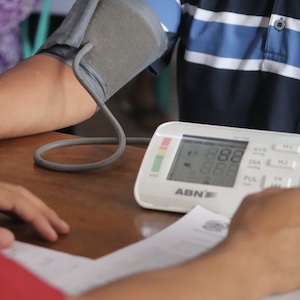Editorials
19 December 2023
Vol. 17 No. 3 (2023)
The 2023 hypertension guidelines of the European Society of Hypertension: a commentary

Publisher's note
All claims expressed in this article are solely those of the authors and do not necessarily represent those of their affiliated organizations, or those of the publisher, the editors and the reviewers. Any product that may be evaluated in this article or claim that may be made by its manufacturer is not guaranteed or endorsed by the publisher.
All claims expressed in this article are solely those of the authors and do not necessarily represent those of their affiliated organizations, or those of the publisher, the editors and the reviewers. Any product that may be evaluated in this article or claim that may be made by its manufacturer is not guaranteed or endorsed by the publisher.
2202
Views
568
Downloads
26
HTML
Authors
University Milano-Bicocca, Milan, Italy.
Clinica Medica, University Milano-Bicocca, Milan, Italy.
University of Brescia, Italy.
Department of Medical and Surgical Sciences, University of Bologna, Italy.
Dept of Clinical and Experimental Sciences, University of Brescia, Italy.
Department of Medicine, University of Padova, Italy.
University Milano-Bicocca, Milan; Dept of Cardiology, Istituto Auxologico Italiano, IRCCS, Milan, Italy.
University of Pisa, Italy.
Dept of Clinical and Experimental Sciences, Charite, University Berlin, Germany.
The 2023 hypertension guidelines of the European Society of Hypertension (ESH) have been published in the December issue of the official Journal of the Society (Journal of Hypertension),1 where they are freely available online. Compared to the guidelines published 5 years ago,2 the new guidelines address issues never or only marginally addressed before, including a large number of comorbidities to hypertension that may change the approach to antihypertensive management. [...]
Mancia G, Kreutz R, Brunström M, et al. 2023 ESH guidelines for the management of arterial hypertension. J Hypertens 2023;41:1874-2071. DOI: https://doi.org/10.1097/HJH.0000000000003480
Williams B, Mancia G, Spiering W, et al. 2018 ESC/ESH Guidelines for the management of arterial hypertension: the task force for the management of arterial hypertension of the European Society of Cardiology and the European Society of Hypertension. J Hypertens 2018;36:1953-2041. DOI: https://doi.org/10.1097/HJH.0000000000001940
Corrao G, Mancia G. Research strategies in treatment of hypertension: value of retrospective real-life data. Eur Heart J 2022;43:3312-22. DOI: https://doi.org/10.1093/eurheartj/ehab899
SCORE 2 Working group and ESC Cardiovascular Risk Collaboration. SCORE 2 risk prediction algorithms: new models to estimate 10-year risk of cardiovascular risk in Europe. Eur Heart J 2021;42:2439-54. DOI: https://doi.org/10.1093/eurheartj/ehab309
Conroy RM, Pyorala K, Fitzgerald A, et al. Estimation of ten-year risk of fatal cardiovascular disease in Europe: the SCORE project. Eur Heart J 2003;24:987-1003. DOI: https://doi.org/10.1016/S0195-668X(03)00114-3
Ciardullo S, Monti T, Sala I, et al. Nonalcoholic fatty liver disease and advanced fibrosis in US adults across blood pressure categories. Hypertension 2020;76:562-8. DOI: https://doi.org/10.1161/HYPERTENSIONAHA.120.15220
Mancia G, Bombelli M, Brambilla G, et al. Long-term prognostic value of white-coat hypertension: an insight from diagnostic use of both ambulatory and home blood pressure measurements. Hypertension 2013;62:168-74. DOI: https://doi.org/10.1161/HYPERTENSIONAHA.111.00690
Sehestedt T, Jeppesen J, Hansen TW, et al. Risk prediction is improved by adding markers of subclinical organ damage to SCORE. Eur Heart J 2010;31:883-91. DOI: https://doi.org/10.1093/eurheartj/ehp546
Mancia G, Laurent S, Agabiti-Rosei E, et al. Reappraisal of European guidelines on hypertension management: a European Society of Hypertension Task Force document. J Hypertens 2009;27:2121-58. DOI: https://doi.org/10.1097/HJH.0b013e328333146d
Mancia G. Evidence in favour of ambulatory blood pressure grows but gaps in knowledge remain. Lancet 2023;401:2014-5. DOI: https://doi.org/10.1016/S0140-6736(23)00442-7
Whelton PK, Carey RM, Aronow WS, et al. 2017 ACC/AHA/AAPA/ABC/ACPM/AGS/APhA/ASH/ASPC/NMA/PCNA Guideline for the Prevention, Detection, Evaluation, and Management of High Blood Pressure in Adults: Executive Summary: A Report of the American College of Cardiology/American Heart Association Task Force on Clinical Practice Guidelines. Hypertension 2018;71:e13-e115. DOI: https://doi.org/10.1161/HYP.0000000000000075
Thomopoulos C, Parati G, Zanchetti A. Effects of blood pressure lowering treatment in hypertension. J Hypertens 2016;34:1451-63. DOI: https://doi.org/10.1097/HJH.0000000000000972
Unger T, Borghi C, Charchar F, et al. 2020 International Society of Hypertension global hypertension practice guidelines. Hypertension 2020;75:1334-57. DOI: https://doi.org/10.1161/HYPERTENSIONAHA.120.15026
Excellence. NIfHaC. National Institute for Health and Clinical Excellence. Hypertension (CG127): clinical management of primary hypertension in adults. Available from: www.nice.org.uk/guidance/CG127 and www.nice.org.uk/guidance/CG1272018.
Mancia G, Zambon A, Soranna D, et al. Factors involved in the discontinuation of antihypertensive therapy: an analysis from real life data. J Hypertens 2014;32:1708-15. DOI: https://doi.org/10.1097/HJH.0000000000000222
Rea F, Corrao G, Merlino L, et al. Initial antihypertensive treatment strategies and therapeutic inertia. Hypertension 2018;72:846-53. DOI: https://doi.org/10.1161/HYPERTENSIONAHA.118.11308
How to Cite
Copyright (c) 2023 the Author(s)


This work is licensed under a Creative Commons Attribution-NonCommercial 4.0 International License.
PAGEPress has chosen to apply the Creative Commons Attribution NonCommercial 4.0 International License (CC BY-NC 4.0) to all manuscripts to be published.






